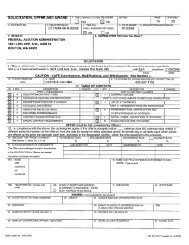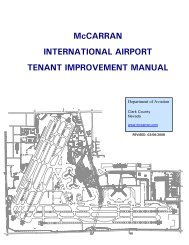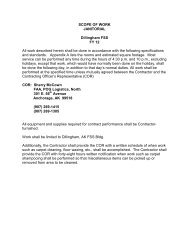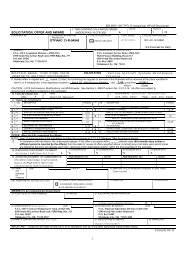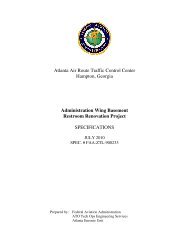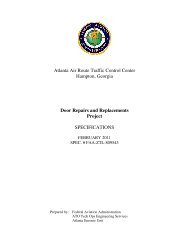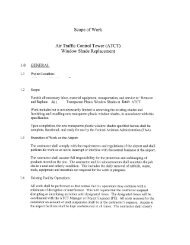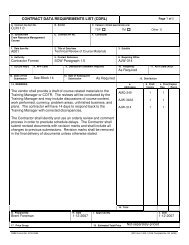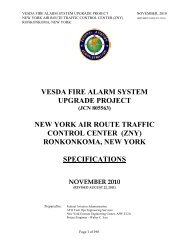specifications - FAACO - Federal Aviation Administration Contract ...
specifications - FAACO - Federal Aviation Administration Contract ...
specifications - FAACO - Federal Aviation Administration Contract ...
Create successful ePaper yourself
Turn your PDF publications into a flip-book with our unique Google optimized e-Paper software.
FTWIC-2235June, 2009plastic layer below. Thoroughly work the concrete around the reinforcement, embeddedfixtures and into the corners and angles of the forms until it is well-compacted.B. Mechanical vibrators shall not be operated so that they penetrate or disturb previouslyplaced layers which are partially set or hardened. They shall not be used to aid the flowof concrete laterally. The vibration shall be of sufficient duration to completely compactand embed reinforcement and fixtures, but not to an extent causing segregation.C. Keep vibrators constantly moving in the concrete and apply vertically at points uniformlyspaced, not farther apart than the radius over which the vibrator is visibly effective. Thevibrator shall not be held in one location longer than required to produce a liquifiedappearance on the surface.D. When submerged in concrete, internal vibrators shall maintain a frequency of not lessthan 6,000 impulses per minute for spuds with diameters greater than 5" and 10,000impulses for smaller spuds. The vibration intensity (amplitude) shall be sufficient toproduce satisfactory consolidation.E. Provide one (1) vibrator (powered pneumatically or electrically) for each ten (10) cubicyards of concrete per hour being placed. Provide at least one (1) vibrator, which may beof the gasoline powered type, as a standby for each two vibrators in service. To producesatisfactory consolidation, and based upon the observed performance, the <strong>Contract</strong>ingOfficer may require the use of a larger sized and powered vibrator.F. Check vibrators intended for regular service or standby service before beginningconcreting operations.3.08 PLACEMENT IN WATER:A. Deposit concrete in water only when dry conditions cannot be obtained. The forms,cofferdams, or caissons shall be sufficiently tight to prevent any water flowing throughthe space where concrete is to be deposited. Pumping of water shall not be permittedwhile the concrete is being placed, nor until it has set for at least thirty-six (36) hours.B. Carefully place the concrete compact mass using a tremie, closed bottom-dumpingbucket, or another approved method which does not permit the concrete to fall throughthe water without protection. The concrete shall not be disturbed after being deposited.Regulate depositing to maintain horizontal surfaces.C. When a tremie is used, it shall consist of a tube constructed in sections having water-tightconnections. The means of supporting the tremie shall permit the movement of thedischarge end over the entire top surface of the work, and shall allow the tremie to berapidly lowered to retard the flow. The number of times it is necessary to shift thelocation of the tremie shall be held to a minimum for any continuous placement ofconcrete. During the placing of concrete, keep the tremie tube full to the bottom of thehopper. When a batch is dumped into the hopper, slightly raise the tremie, but not out ofthe concrete at the bottom, until the batch discharges to the level of the bottom of thehopper. Stop the flow by lowering the tremie. Continue pacing operations until the workis completed.03300-21



